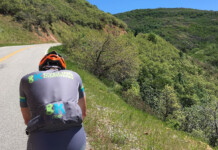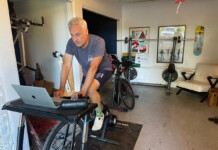By Mark Deterline
Bike fit has become an essential part of owning good bikes that we want to ride as efficiently and as comfortably as possible.
Dave and I originally sought training and certification from the world’s top fitters primarily so that we could support our coaching clients in their quest for maximum performance. Over time, we have done more and more bike fits for clients and non-clients alike based on a variety of needs.
The whys
Proper bike fit offers the following benefits:
• Relief from discomfort
• Relief from injury
• Improved biomechanics & efficiency
• Better, more confident bike handling
• Increased power
One of the primary motivators that get cyclists to invest time and money in a bike fit is discomfort. Feet, bums or hands get sore or go numb, lower back muscles tighten, necks ache. Often these symptoms are less about the body part itself, and more about improper biomechanics somewhere along the chain of contact that manifest themselves in a part of the body that compensates.
Injuries result from accidents or ailments unrelated to cycling, but can also be related to cycling, with improper fit being a common culprit.
Another catalyst is the realization that we are only as effective and fast as our technique allows us to be. In many instances riders recognize that their “form” or position is not optimized, because they feel or intuit inefficiencies. These are often very real sensations. Sure, we can overanalyze and overthink things, and we tend to be most critical of or hardest on ourselves. However, if we are generally positive about our efforts on the bike yet still discern issues, we could very well be onto something. Proprioception is a key facet of today’s most sophisticated bike fit processes, which will be addressed in-depth later in this article.
One exciting reason cited by many of our clients is the desire to feel more confident handling their bikes – whether on road or trail, climbs or descents, in corners or crosswinds. This aspect is sublime because it goes beyond alleviating discomfort and inefficiencies, focusing on… having fun and becoming one with the most awesome of human tools!
Finally, there is power. Maximum power transfer allows us to conquer the most formidable terrain and satisfy that need for speed inherent in most of us, and which got many of us into cycling in the first place. Maximum power transfer allows us to kick butt, sure, but there is also beauty and accomplishment in knowing that we have optimized our biomechanics and eliminated inefficiencies, like a customized, clean burning speed machine.
Pieces of a puzzle, spokes on a wheel
Bike fit adjustments can be likened to adjusting the tension of single spokes: each change to a single part affects other parts and therefore the whole. That is why there are generally no easy fixes or single adjustments that will lead to an optimal fit.
That isn’t to say that small improvements can’t be made; a little research or help from competent bike shop staff can alleviate pressure or strain on a knee or get someone more comfortable on a saddle or in a pair of shoes. However, a rider should be realistic about how much can be accomplished using fixed angles, set formulas, shoe insoles, new component parts, etc. After all, everything still needs to be integrated and fit to the rider, instead of the other way around.
The hows: Help me help you
Each of us has a unique anatomical structure to begin with, and a physiology that is largely the result of lifestyle and physical conditioning. Both change over time, modified by how we care for our bodies and our level – and type – of fitness. All of these variables dictate that at the outset of a proper bike fit, ideally there should be no anticipated outcomes. The process should be based on a rigorous protocol, yes, but it is largely a process of discovery for both fitter and subject.
Which leads us to proprioception. A good fitter goes through a protocol that establishes benchmarks, but only as an initial step. Much of a good fit, and why ours take 2+ hours, is that we then take the rider through a process of experimentation and elimination, much like a patient undergoes at the optometrist. There is no way to perceive with exactness what an individual experiences; we can observe, intuit and make educated assumptions, but ultimately an expert must elicit and process feedback. Hence the practice of the optometrist taking a patient through the steps of “better now, or better now” until the ideal visual prescription is determined.
This dimension of modern bike fit is not warm and fuzzy, nor based on personal preferences. It is a dramatic process that releases tensions, enables movement and unleashes power that most of our clients hadn’t fully anticipated. It manifests itself in enhanced comfort and increased performance that energize a rider.
What is actually happening when we facilitate proper hip/pelvic rotation; support optimally the feet via the forefeet, aligning hips, knees and ankles; as well as support and release undue strain on the upper body is a concept we refer to as postural liberation. Proprioception is possible because the body recognizes when it is allowed to move the way it wants to, and when tension is released. The only muscles we want working are the ones moving the pedals and propelling us forward, and to a much lesser degree the ones instinctively engaged to maneuver and steer the bike.
Getting there
Naturally, we encourage anyone who plans to spend significant time on a bike to get a professional bike fit. We have invested hundreds of hours in research and training, and have conducted hundreds of bike fits. Competent professional fitters have the tools, dedication and the humble understanding that client feedback based on proprioception leads to postural liberation – to the true remedying of underlying biomechanical issues due to bodily asymmetries, injuries or improper positioning.
Additionally, it is important to recognize that each type of bike – road, mountain, cyclocross, track, etc – requires a different type of fit to facilitate each discipline and its unique biomechanical demands.
We offer all of these thoughts to encourage each rider to pursue optimized fit and positioning, and to get started somewhere. We strongly recommend a professional fit; at least not ruling it out until the rider experiences that liberation and comfort that lasts as long as the longest and hardest ride one ever plans to do on a bike.
Mark Deterline and Dave Harward offer over thirty years of combined endurance training and competitive experience. Plan 7 Endurance Coaching provides professional coaching, biomechanics (bike fitting and stride analysis) and performance testing for athletes of all levels. Email them at: contact@plan7coaching.com.






